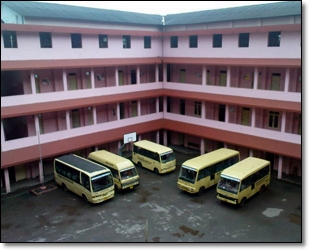Basic Education: Challenges and Opportunities
By Philip Mudartha
Bellevision Media Network
24 Jul 2013: Continuing the education series, in this third chapter, we will critically examine schools at primary, elementary, secondary and senior secondary levels. This is because basic education is the foundation of high scholastic achievements in colleges and universities. It is universally accepted that a good beginning is half the work done.
The Bare Essentials of a good Basic Education: sound school Infrastructure
 The primary schools enroll students in Class 1 and pass them out at Class 5. Small and even remote villages have them. It is no longer necessary for children aged 6 to 11 to travel far from their homes. Enrolment in government and aided private schools is free; there is no tuition fee. Teachers in these schools are paid directly from public treasury according to pay-scales fixed periodically by government education authorities. However, the student-teacher ratio is fixed at 40:1. The only difference is the ownership and management of school infrastructure. The management and trustees of aided private schools raise and provide funds to build, maintain and expand school facilities. Good school facilities are very important for good learning outcomes.
The primary schools enroll students in Class 1 and pass them out at Class 5. Small and even remote villages have them. It is no longer necessary for children aged 6 to 11 to travel far from their homes. Enrolment in government and aided private schools is free; there is no tuition fee. Teachers in these schools are paid directly from public treasury according to pay-scales fixed periodically by government education authorities. However, the student-teacher ratio is fixed at 40:1. The only difference is the ownership and management of school infrastructure. The management and trustees of aided private schools raise and provide funds to build, maintain and expand school facilities. Good school facilities are very important for good learning outcomes.
Classrooms, blackboards, flags, maps, charts, posters, library, books, workshop for craft, laboratory for practical observations of scientific phenomena, indoor sports facilities and toys, outdoor play-ground, toilets, and a canteen/mid-day meal facility are important. The students and their parents are advised to personally check not only the availability but operational condition of these facilities. It is the duty of every parent to ensure that his/her child is provided with good learning environment. Today, even poor parents have great aspirations for their children. They are instinctively aware of the co-relationship between level of education and future income. Of course, Indian researchers have established that a pass in secondary school examination brings greater economic returns in the job market.
The quality and commitment of teachers for good learning outcomes is a must
As a manager in industrial production facility, I often remarked on the key role of human resources. A pet example is Air India and Qatar Airways. Both own and operate planes manufactured and supplied by Boeing and Airbus to same quality standards. What do you think their customer ratings are? Qatar Airways wins hands down. It boasts of being the 5-star airline because its customers rate its service performance very high. It is due to quality and commitment of the people who man the machines and interface with customers that makes all the difference.
 Providing basic education is a similar service as operating commuter flights. The best of school infrastructure in the wrong hands does not amount to much in delivering learning outcomes. The quality of its teachers is foremost. Quality of teachers is measureable. Parents enrolling their children in schools should seek information on academic qualifications, their scholastic and overall achievement and their track record in both attendance and classroom performance. Today, most parents have the ability to evaluate primary, secondary and senior secondary school teachers in 10+2 systems. If they actually do so is a question I leave to my readers to provide anecdotal feedback.
Providing basic education is a similar service as operating commuter flights. The best of school infrastructure in the wrong hands does not amount to much in delivering learning outcomes. The quality of its teachers is foremost. Quality of teachers is measureable. Parents enrolling their children in schools should seek information on academic qualifications, their scholastic and overall achievement and their track record in both attendance and classroom performance. Today, most parents have the ability to evaluate primary, secondary and senior secondary school teachers in 10+2 systems. If they actually do so is a question I leave to my readers to provide anecdotal feedback.
Commitment of teachers is a major factor in determining learning outcomes. Teachers may have best academic qualifications and years of service record. They may have sweet and pleasing, and near awe-inspiring personality. Yet, they would deliver poor learning outcomes if they lack commitment. Commitment is measureable. Attendance is a primary criterion. These days, teachers play truant more than students. The teachers are more undisciplined than their students. They are known to report for marking their attendance and then disappear into staff rooms or on personal errands to markets. The unaccountability of teachers is a major problem in most Indian public schools, especially government owned and some aided private schools. Parents have to give due weightage to teacher quality and commitment in their choice of a school. Further, they must attend parent-teacher meetings regularly. They must not be mute party letting the teacher to do all the talking but seek information on teacher quality and teaching performance.
In fact, the Parent-Teacher Association, Od Students’ Association and other alumni associations must assert themselves in their interactions with management boards of government schools, management correspondents and trustees with the objective of making the teachers accountable not only to the school managements but to the community which the schools serve.
Yeh Public Hei, Sab Janti Hei
The enrolment in Class 1 has reached 96% in most Indian states. Both central and state governments are allocating increasingly higher funds each year to achieve goals of eradication of illiteracy. Right to Education (RTE) Act has been passed. A 3% education cess (surcharge) is levied on most taxes to fund public education. Government budgets are announcing new and innovative schemes and incentives to attract even children of nomadic tribes unwilling to join the national mainstream. Further to government efforts, as I have mentioned in Chapter-2, private educationists have entered into fray with an eye on future financial dividends. NGOs, philanthropists, social activists, and corporates are setting up schools with a faster pace than ever before. The supply and demand situation will tilt in favor of students, which means parents and students will have greater choice tomorrow than yesterday. In states like Karnataka where Total Fertility Rate (TFR) is below national average and especially in districts of Udupi and DK where it is even below required for sustain population size, schools will have to clean up their act or shut shop. Quality, not quantity, is the new slogan.
 The public is deserting public schools, especially government schools, mainly because of poor teaching quality. The government teachers are paid very well. A national study shows they are paid three to five times the wages paid to private school teachers. Higher wages have not improved teacher quality. They play as truant as before pay revisions. They allow and even abet cheating in examinations, permit mass copying and dole out high marks in exchange for gifts. They bribe 1 lac or more to secure permanent teaching jobs in many government schools. Such moral and ethical bankruptcy is a black spot on the noble profession of teaching; unthinkable it may be, but sadly it is the reality.
The public is deserting public schools, especially government schools, mainly because of poor teaching quality. The government teachers are paid very well. A national study shows they are paid three to five times the wages paid to private school teachers. Higher wages have not improved teacher quality. They play as truant as before pay revisions. They allow and even abet cheating in examinations, permit mass copying and dole out high marks in exchange for gifts. They bribe 1 lac or more to secure permanent teaching jobs in many government schools. Such moral and ethical bankruptcy is a black spot on the noble profession of teaching; unthinkable it may be, but sadly it is the reality.
The public therefore is flocking to unaided private schools. These can be set up with a fraction of cost that government schools incur. They do not need government recognition. There are recognized unaided private schools affiliated to boards of control I mentioned in Chapter-2. But a bulk of unaided private schools without government recognition who enroll students, adhere to syllabi and curricula of recognized boards, and prepare students to appear for board examinations or those conducted by NIOS, an open schooling system approved by Indian Government.
Possible collapse of public schools at high school level
Specific official data is not available but household surveys have shown that more than a quarter of 6 year old Indians are enrolling into fee-paying private schools. Last month, I was in a South Indian village which has high BPL households to meet one of my sponsored students. More than 50% had enrolled in English medium unaided private elementary school; whereas, the temple managed non-fee paying Kannada medium aided elementary school with significantly superior school facilities struggled to fill its strength of 40 per class. It had only 198 students in 7 classes, thus becoming eligible for 5 regular teachers paid from treasury. It hired 2 temporary Para-teachers on annual contract, on its own salary terms, which were 12-15% of government pay scale. Reports indicate that there are even one teacher elementary schools.
The failure of government schools due to teachers’ ineptitude and incompetence is a boon to unaided private schools. There are plenty of unemployed graduates willing to take up teaching jobs at market rate, which is very low at about one-fifth of a permanent government school teacher’s pay. The powerful teacher unions have extracted from successive governments pay revisions without any linkage to their and school performance. On the contrary, managements of unaided fee-charging private schools with their low-paid teachers have disciplined them and extracted long hours of work without mercy. They have gained reputation as quality institutions of basic education, attracting more students and charging higher tuition fees. They are already becoming profitable, with some help from donors and sponsors.
Education is a priority concern for each one of us: parents, students, teachers, and school management trustees. What is your take on this discussion? I would like this to be an interactive session.
Also Read
Part 1 : The resurrection of Humanities Stream in degree programs
Part 2 : The secondary school courses of study and syllabi
 Write Comment |
Write Comment |  E-Mail To a Friend |
E-Mail To a Friend |
 Facebook |
Facebook |
 Twitter |
Twitter |
 Print
Print 

















